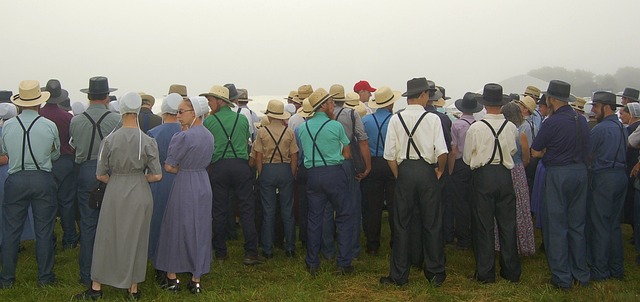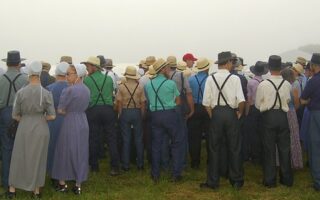The Amish, a traditionalist Christian group, have unique practices and beliefs that shape their way of life. One aspect that sets them apart is their approach to transportation. Due to their commitment to simplicity and separation from modern society, the Amish have developed alternative methods for traveling long distances. In this article, we will explore how the Amish navigate long journeys while adhering to their cultural values.
Table of Contents
Traditional Modes of Transportation Used by the Amish for Long Distances
The Amish are known for their simple and traditional way of life. They live without many modern conveniences, including cars and airplanes. So, how do they travel long distances? The answer lies in the traditional modes of transportation that the Amish have been using for centuries.
One of the most common ways the Amish travel long distances is by horse and buggy. This iconic image of the Amish traveling down country roads is a familiar sight in many rural communities. The horse and buggy is not only a means of transportation for the Amish, but it is also a symbol of their way of life. It represents their commitment to simplicity and their desire to live in harmony with nature.
The horse and buggy is a practical mode of transportation for the Amish. Horses are able to cover long distances at a steady pace, and they can navigate rough terrain that would be difficult for a car to traverse. Buggies are designed to be sturdy and durable, able to withstand the rigors of long journeys. They are also equipped with basic amenities such as seats and a roof to protect the passengers from the elements.
In addition to horse and buggy, the Amish also use bicycles for long-distance travel. Bicycles are a more modern mode of transportation compared to horse and buggy, but they still fit within the Amish way of life. Bicycles are simple and require no fuel other than human power. They are also relatively inexpensive and easy to maintain.
Bicycles are particularly popular among the younger generation of Amish. They provide a sense of independence and freedom, allowing the Amish to explore the world beyond their communities. Bicycles are also a practical mode of transportation for shorter distances, such as running errands or visiting nearby friends and family.
For longer distances, the Amish may also use trains or buses. While these modes of transportation are not as common as horse and buggy or bicycles, they are still used when necessary. Trains and buses provide a faster and more efficient way to travel long distances, especially when time is of the essence.
When the Amish do use trains or buses, they often do so as a group. This allows them to maintain their sense of community and togetherness, even when traveling far from home. It also helps to reduce costs, as they can share the expenses of the journey.
In conclusion, the Amish have a variety of traditional modes of transportation that they use for long distances. From the iconic horse and buggy to bicycles, trains, and buses, the Amish have found practical and sustainable ways to travel without relying on modern technology. These modes of transportation not only serve a practical purpose but also reflect the Amish commitment to simplicity and their desire to live in harmony with nature. So, the next time you see an Amish person traveling down the road in a horse and buggy or on a bicycle, remember that they are not just getting from point A to point B, but they are also carrying on a rich tradition that has been passed down through generations.
The Role of Horse and Buggy in Amish Long-Distance Travel

Have you ever wondered how the Amish manage to travel long distances without the use of modern transportation? It’s a fascinating question that sheds light on the unique lifestyle of this traditional community. One of the key elements in Amish long-distance travel is the use of horse and buggy. This traditional mode of transportation has been a part of Amish culture for centuries and continues to play a vital role in their daily lives.
The horse and buggy is not just a means of getting from point A to point B for the Amish; it is a symbol of their commitment to simplicity and their desire to live in harmony with nature. The horse, a gentle and loyal creature, is seen as a partner in their journey, and the buggy, a simple and practical vehicle, is a reflection of their values.
When it comes to long-distance travel, the Amish rely on their horses and buggies to get them where they need to go. Whether it’s a trip to the market, a visit to a neighboring community, or even a journey to a different state, the horse and buggy is their trusted mode of transportation. It may not be the fastest or most convenient way to travel, but for the Amish, it is the most meaningful and sustainable option.
One of the advantages of using a horse and buggy for long-distance travel is the opportunity for connection and reflection. Unlike traveling in a car or on a train, where the focus is often on reaching the destination as quickly as possible, traveling in a horse and buggy allows the Amish to slow down and appreciate the journey. They can take in the sights and sounds of the countryside, engage in conversation with their fellow travelers, and enjoy the simple pleasures of being in nature.
Of course, traveling long distances in a horse and buggy requires careful planning and preparation. The Amish are known for their meticulous attention to detail, and this extends to their travel arrangements as well. They ensure that their horses are well-fed and rested before embarking on a long journey, and they pack enough supplies to sustain them along the way. They also take into account the weather conditions and plan their travel accordingly, making sure to avoid traveling during extreme heat or cold.
In addition to the practical considerations, the Amish also have a strong sense of community when it comes to long-distance travel. They often travel in groups, with several families joining together for a shared journey. This not only provides companionship and support but also allows for the sharing of resources and responsibilities. It is not uncommon to see Amish families traveling together, with children playing games and adults engaging in conversation as they make their way to their destination.
In conclusion, the horse and buggy play a crucial role in Amish long-distance travel. It is not just a mode of transportation but a symbol of their commitment to simplicity and their desire to live in harmony with nature. Traveling in a horse and buggy allows the Amish to slow down, appreciate the journey, and connect with their surroundings. It requires careful planning and preparation, as well as a strong sense of community. So, the next time you see an Amish family traveling in their horse and buggy, take a moment to appreciate the beauty and significance of their chosen mode of transportation.
Exploring Amish Travel Practices: From Bicycles to Trains
How Do Amish Travel Long Distances?
When you think of the Amish, you might picture horse-drawn buggies and a simple way of life. It’s true that the Amish community embraces a traditional lifestyle, but that doesn’t mean they don’t travel long distances. In fact, the Amish have developed unique travel practices that allow them to journey far from their homes while still adhering to their beliefs.
One of the most common modes of transportation for the Amish is the bicycle. You might be surprised to learn that bicycles are widely accepted within the Amish community. They are seen as a practical and efficient way to get around, especially for shorter distances. Bicycles allow the Amish to travel quickly and easily, without relying on modern technology or fossil fuels. It’s not uncommon to see Amish individuals or families riding their bicycles along country roads, their bonnets and straw hats bobbing in the wind.
For longer distances, the Amish often turn to trains. Trains provide a convenient and reliable means of transportation for the Amish community. They can travel long distances without the need for personal vehicles or extensive planning. Train travel also aligns with their values of simplicity and community. When a group of Amish families needs to travel together, they can book a private train car, allowing them to maintain their sense of community while on the move.
Of course, there are times when the Amish need to travel even farther, beyond the reach of bicycles or trains. In these cases, they may turn to commercial buses or even airplanes. While these modes of transportation may seem contradictory to their traditional lifestyle, the Amish are pragmatic in their approach. They recognize that sometimes, modern conveniences are necessary for certain journeys. However, they still strive to maintain their values and minimize their reliance on technology whenever possible.
When it comes to long-distance travel, the Amish have a unique approach that sets them apart from the rest of society. They prioritize simplicity and community, even when they’re on the move. Whether it’s pedaling along on their bicycles, riding the rails of a train, or boarding a commercial bus or airplane, the Amish find ways to travel that align with their beliefs.
It’s important to note that not all Amish individuals or communities embrace the same travel practices. The Amish are a diverse group, with different communities and sects having their own unique customs and traditions. Some may be more open to modern modes of transportation, while others may strictly adhere to traditional methods. It’s this diversity that makes the Amish community so fascinating and worthy of exploration.
In conclusion, the Amish have developed a variety of travel practices that allow them to journey long distances while still adhering to their beliefs. From bicycles to trains, and even commercial buses and airplanes, the Amish find ways to travel that align with their values of simplicity and community. Their unique approach to travel sets them apart and makes them an intriguing group to learn about. So, the next time you see an Amish individual or family on a bicycle or boarding a train, take a moment to appreciate their commitment to their way of life, even when they’re on the move.
Challenges and Adaptations: How the Amish Navigate Long-Distance Travel in the Modern World
How Do Amish Travel Long Distances?
The Amish are known for their simple and traditional way of life, which includes a reluctance to embrace modern technology. However, in today’s interconnected world, long-distance travel has become a necessity for many people. So, how do the Amish navigate long distances without the use of cars, planes, or trains?
One of the main challenges the Amish face when it comes to long-distance travel is the lack of access to modern transportation. Unlike most people, they do not own cars or use public transportation. Instead, they rely on more traditional methods of travel, such as horse-drawn buggies and bicycles.
Horse-drawn buggies are a common sight in Amish communities. These buggies are typically pulled by a single horse and are used for short-distance travel within the community. However, when it comes to longer distances, the Amish have to get creative.
One adaptation the Amish have made to overcome this challenge is the use of hired drivers. When an Amish person needs to travel a long distance, they can hire a driver who owns a car. This allows them to reach their destination without compromising their beliefs. The hired driver is usually a member of the Amish community who has chosen to embrace modern technology and is willing to provide transportation services to their fellow community members.
Another option for long-distance travel is the use of public transportation. While the Amish do not own cars, they can still take advantage of buses and trains. However, this option is not without its challenges. The Amish have strict rules regarding the use of technology, and many forms of public transportation rely heavily on modern technology. For example, purchasing a bus or train ticket often requires the use of a credit card or an online booking system, both of which are not in line with Amish beliefs.
To overcome this challenge, the Amish have developed a system of intermediaries. These intermediaries, often non-Amish individuals, act as a bridge between the Amish and the modern world. They help the Amish with tasks such as purchasing tickets, making reservations, and navigating the complexities of modern transportation systems. This allows the Amish to travel long distances while still adhering to their beliefs.
In addition to hired drivers and intermediaries, the Amish also rely on their strong sense of community to navigate long-distance travel. When an Amish person needs to travel, they often reach out to their fellow community members for assistance. This can include asking for a ride, borrowing a bicycle, or even arranging a group trip. By relying on their community, the Amish are able to overcome the challenges of long-distance travel without compromising their way of life.
In conclusion, the Amish face unique challenges when it comes to long-distance travel in the modern world. However, through a combination of hired drivers, intermediaries, and community support, they have found ways to navigate these challenges while still adhering to their traditional beliefs. While their methods may be different from those of the majority, the Amish demonstrate that it is possible to travel long distances without relying on modern technology.
Conclusion
In conclusion, the Amish typically travel long distances by using horse-drawn carriages or buggies as their primary mode of transportation. They adhere to traditional practices and avoid modern technologies such as cars and airplanes. This allows them to maintain their simple and self-sufficient way of life while traveling to distant locations.
For licensing reasons, we must provide the following notice: This content was created in part with the help of an AI.


